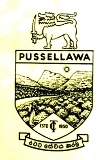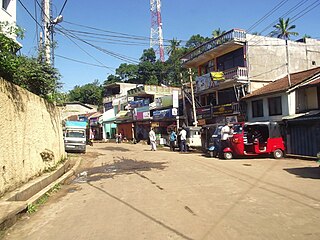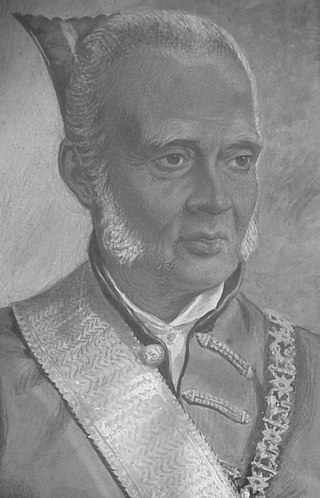
Sir Thomas Johnstone Lipton, 1st Baronet was a Scotsman of Ulster-Scots parentage who was a self-made man, as company founder of Lipton Tea, merchant, philanthropist and yachtsman who lost 5 straight America's Cup races.

Hatton is a major town in the Nuwara Eliya District of Central Province, Sri Lanka governed by the Hatton-Dickoya Urban Council. Hatton is a major centre of the Sri Lankan tea industry.

Indian Tamils of Sri Lanka are Tamil people of Indian origin in Sri Lanka. They are also known as Malayaga Tamilar, Hill Country Tamils, Up-Country Tamils or simply Indian Tamils. They predominantly descend from workers sent from Southern India to Sri Lanka in the 19th and 20th centuries to work in coffee, tea and rubber plantations. Some also migrated on their own as merchants and as other service providers. These Tamil speakers mostly live in the central highlands, also known as the Malayakam or Hill Country, yet others are also found in major urban areas and in the Northern Province. Although they are all termed as Tamils today, some have Telugu and Malayalee origins as well as diverse South Indian caste origins. They are instrumental in the plantation sector economy of Sri Lanka. In general, socio-economically their standard of living is below that of the national average and they are described as one of the poorest and most neglected groups in Sri Lanka. In 1964 a large percentage were repatriated to India, but left a considerable number as stateless people. By the 1990s most of these had been given Sri Lankan citizenship. Most are Hindus with a minority of Christians and Muslims amongst them. There are also a small minority followers of Buddhism among them. Politically they are supportive of trade union-based political parties that have supported most of the ruling coalitions since the 1980s.

Pussellawa Sinhala: පුස්සැල්ලාව. Tamil: புசல்லாவ, is a l town in Kandy District, Sri Lanka. It is located along the A5 road between Gampola and Nuwara Eliya.

Lipton is a British brand of tea, soup, and dipping sauce, owned by Lipton Teas and Infusions. Lipton was also the name of a supermarket chain in the United Kingdom, owned by Allied Suppliers, which was sold to Argyll Foods in 1982, after which the brand was used only for tea, soup, and dipping sauce. The company, which is named after its founder, Sir Thomas Lipton, who started the business it in 1890, was owned by Unilever for many decades until its sale to CVC Capital Partners in 2022. Lipton’s ready to drink beverages are sold by "Pepsi Lipton International", a company jointly owned by Unilever and PepsiCo.

British Ceylon, officially British Settlements and Territories in the Island of Ceylon with its Dependencies from 1802 to 1833, then the Island of Ceylon and its Territories and Dependencies from 1833 to 1931 and finally the Island of Ceylon and its Dependencies from 1931 to 1948, was the British Crown colony of present-day Sri Lanka between 1796 and 4 February 1948. Initially, the area it covered did not include the Kingdom of Kandy, which was a protectorate, but from 1817 to 1948 the British possessions included the whole island of Ceylon, now the nation of Sri Lanka.

The Loolecondera estate was the first tea plantation estate in Sri Lanka, established in 1867 by Scotsman James Taylor. The estate is located 35 km (22 mi) southeast of Kandy, Sri Lanka.

Galaha is a small town located in the central Sri Lanka. Situated at an elevation of about 700 metres (2,300 ft), it is one of the first tea planted areas in Sri Lanka, 20 kilometres (12 mi) south of Kandy. And 19 kilometres (12 mi) from Gampola town and 5 kilometres (3.1 mi) from Deltota town.

The primary form of agriculture in Sri Lanka is rice production. Rice is cultivated during Maha and Yala seasons. Tea is cultivated in the central highlands and is a major source of foreign exchange. Vegetables, fruits and oilseed crops are also cultivated in the country. There are two Agriculture Parks abbreviated as A. Parks established by the Department of Agriculture. Out of the total population in Sri Lanka, 27.1% engages in agricultural activities. Agriculture accounted for 7.4% of the GDP in 2020.
Delthota is a small town in Kandy District, Sri Lanka. The town is located near to Nuwara Eliya District, and has a climate similar to that found in Nuwara Eliya, which often requires to wear a jacket to keep yourself warm.

Tea consumption is an essential part of contemporary Australian culture, generally inherited from British tea culture though with its own distinct qualities. Small quantities of tea are grown and produced in Australia itself.

Gate Mudaliyar Jeronis de Soysa was a pioneering Ceylonese entrepreneur and philanthropist. He was a pioneer coffee planter and an industrialist who became the wealthiest Ceylonese of the 19th century by establishing the largest native commercial enterprise of the era. He was instrumental in the establishment of the first Ceylonese bank and is often referred to as a father of private enterprise in British Ceylon. He was the first Mudaliyar to be elevated in recognition of his philanthropy.

The Ceylon Tea Museum is located in the former Hanthana Tea Factory, which was originally constructed in 1925. It is situated 3 km (1.9 mi) south of Kandy.

Sri Lanka has a climate and varied elevation that allows for the production of both Camellia sinensis var. assamica and Camellia sinensis var. sinensis, with the assamica varietal holding the majority of production. Tea production is one of the main sources of foreign exchange for Sri Lanka, and accounts for 2% of GDP, contributing over US$1.3 billion in 2021 to the economy of Sri Lanka. It employs, directly or indirectly, over 1 million people, and in 1995 directly employed 215,338 on tea plantations and estates. In addition, tea planting by smallholders is the source of employment for thousands whilst it is also the main form of livelihood for tens of thousands of families. Sri Lanka is the world's fourth-largest producer of tea. In 1995, it was the world's leading exporter of tea, with 23% of the total world export, and Sri Lanka ranked second on tea export earnings in 2020 after China. The highest production of 340 million kg was recorded in 2013, while the production in 2014 was slightly reduced to 338 million kg. India has additionally guaranteed Sri Lanka a shipment of 65,000 metric tons of urea. Sri Lanka's troubled execution of an organic agriculture initiative had pushed the country perilously close to an agricultural crisis. Given the surge in global fertilizer prices, it is improbable that Sri Lanka could procure fertilizer at prevailing market rates.
Norman Rowsell was an Englishman who was one of the first tea planters in British Ceylon. He was also a well known sportsman and became the first Ceylon Labour Commissioner.
Reginald Percy Gaddum was a tea planter in Ceylon and a member of parliament from 1952 to 1956.

Walker Sons and Company was an engineering firm established in Kandy in 1854 by a Scottish engineer, John Walker, as John Walker and Co. It was the seventh oldest operating company in Sri Lanka. Today, the name operates as an investment holding company under the umbrella of the MTD Walkers group, but ceased operations in its original form in the 1980s.

Charles Spearman Armstrong (1847–1924) was an Irish-born pioneer of tea and cinchona in British Ceylon, where he arrived in 1863.

Brown and Company PLC, sometimes called Browns Group, is a conglomerate holding company in Sri Lanka. The company was founded by James Brown, a 25-year-old engineer and mechanic from London who arrived in Ceylon in 1872. In 1892, the company was incorporated and in 1991 the company became a listed company on the Colombo Stock Exchange. The company was included in S&P Sri Lanka 20 Index in June 2021. Brown and Company is one of the LMD 100 companies, an annual list of Sri Lankan listed companies by revenue, having ranked 42nd in the 2020/21 edition.


















